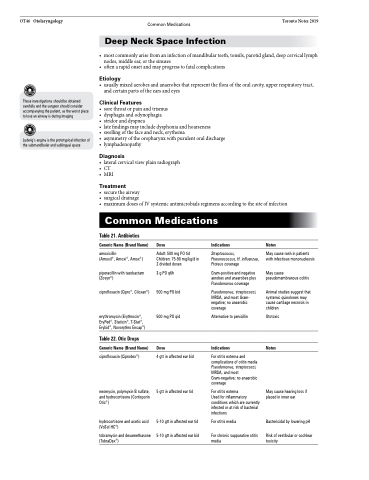Page 1032 - TNFlipTest
P. 1032
OT46 Otolaryngology
These investigations should be obtained carefully and the surgeon should consider accompanying the patient, as the worst place to lose an airway is during imaging
Ludwig’s angina is the prototypical infection of the submandibular and sublingual space
Common Medications Toronto Notes 2019 Deep Neck Space Infection
• mostcommonlyarisefromaninfectionofmandibularteeth,tonsils,parotidgland,deepcervicallymph nodes, middle ear, or the sinuses
• oftenarapidonsetandmayprogresstofatalcomplications
Etiology
• usuallymixedaerobesandanaerobesthatrepresentthefloraoftheoralcavity,upperrespiratorytract, and certain parts of the ears and eyes
Clinical Features
• sorethroatorpainandtrismus
• dysphagiaandodynophagia
• stridoranddyspnea
• latefindingsmayincludedysphoniaandhoarseness • swellingofthefaceandneck,erythema
• asymmetryoftheoropharynxwithpurulentoraldischarge • lymphadenopathy
Diagnosis
• lateralcervicalviewplainradiograph • CT
• MRI
Treatment
• securetheairway
• surgicaldrainage
• maximumdosesofIVsystemicantimicrobialsregimensaccordingtothesiteofinfection
Common Medications
Table 21. Antibiotics
Generic Name (Brand Name)
amoxicillin
(Amoxil®, Amoxi®, Amox®)
piperacillin with tazobactam (Zosyn®)
ciprofloxacin (Cipro®, Ciloxan®)
erythromycin (Erythrocin®, EryPed®, Staticin®, T-Stat®, Erybid®, Novorythro Encap®)
Table 22. Otic Drops
Generic Name (Brand Name)
ciprofloxacin (Ciprodex®)
neomycin, polymyxin B sulfate, and hydrocortisone (Cortisporin Otic®)
hydrocortisone and acetic acid (VoSol HC®)
tobramycin and dexamethasone (TobraDex®)
Dose
Adult: 500 mg PO tid Children: 75-90 mg/kg/d in 2 divided doses
3 g PO q6h 500 mg PO bid
500 mg PO qid
Dose
4 gtt in affected ear bid
5 gtt in affected ear tid
5-10 gtt in affected ear tid 5-10 gtt in affected ear bid
Indications
Streptococcus, Pneumococcus, H. influenzae, Proteus coverage
Gram-positive and negative aerobes and anaerobes plus Pseudomonas coverage
Pseudomonas, streptococci, MRSA, and most Gram- negative; no anaerobic coverage
Alternative to penicillin
Indications
For otitis externa and complications of otitis media Pseudomonas, streptococci, MRSA, and most Gram-negative; no anaerobic coverage
For otitis externa
Used for inflammatory conditions which are currently infected or at risk of bacterial infections
For otitis media
For chronic suppurative otitis media
Notes
May cause rash in patients with infectious mononucleosis
May cause pseudomembranous colitis
Animal studies suggest that systemic quinolones may cause cartilage necrosis in children
Ototoxic
Notes
May cause hearing loss if placed in inner ear
Bactericidal by lowering pH
Risk of vestibular or cochlear toxicity


